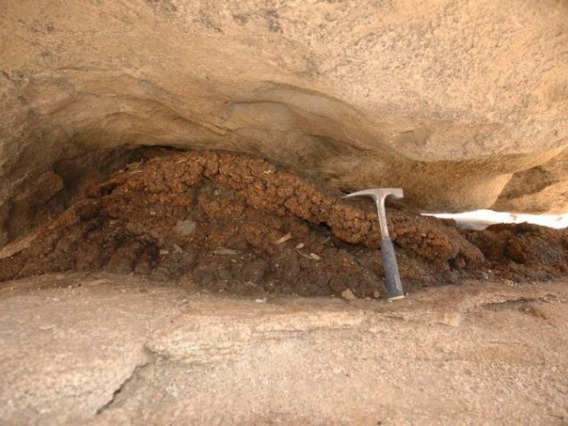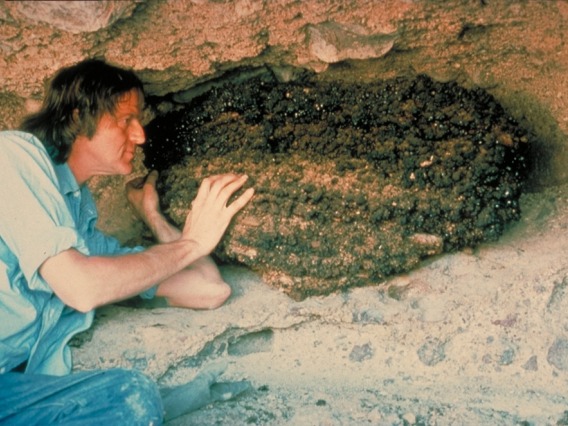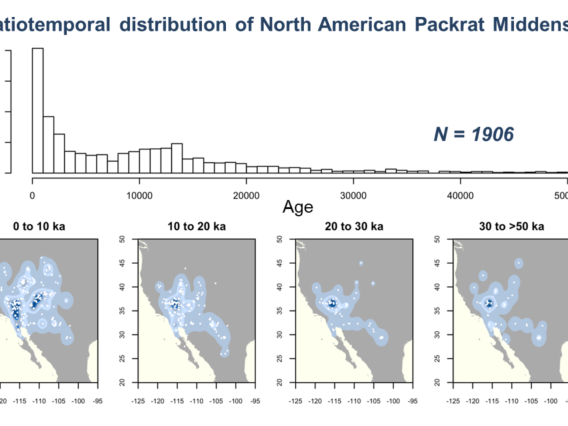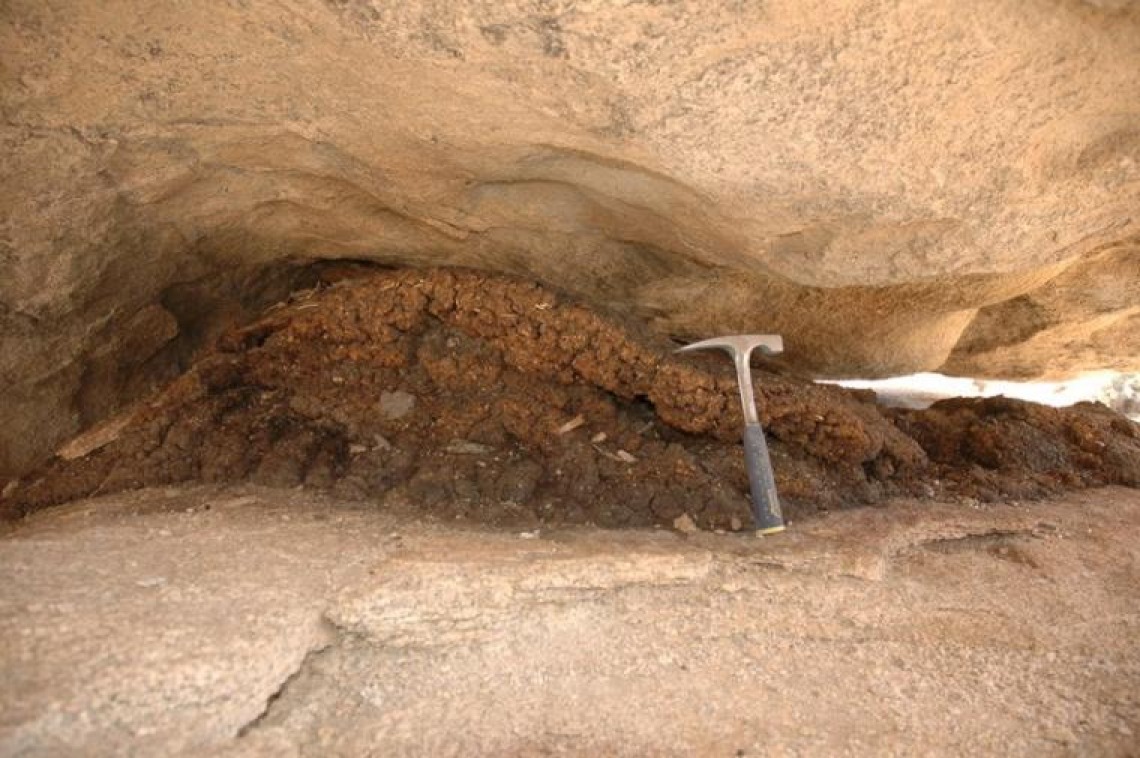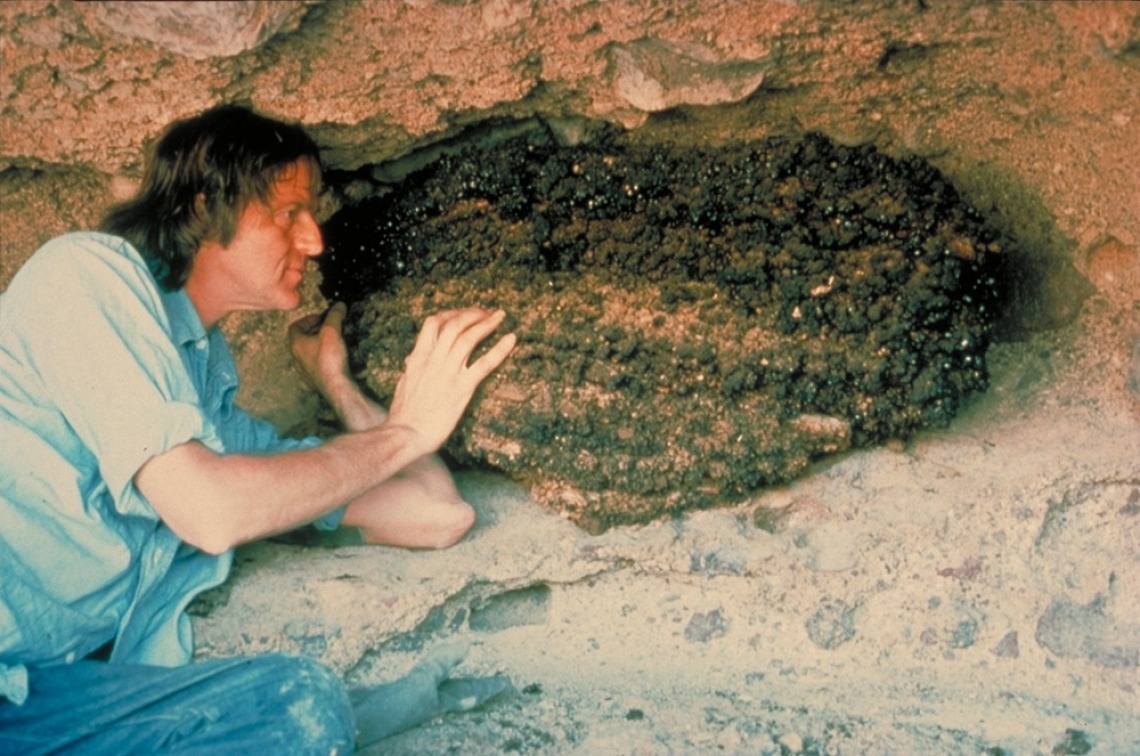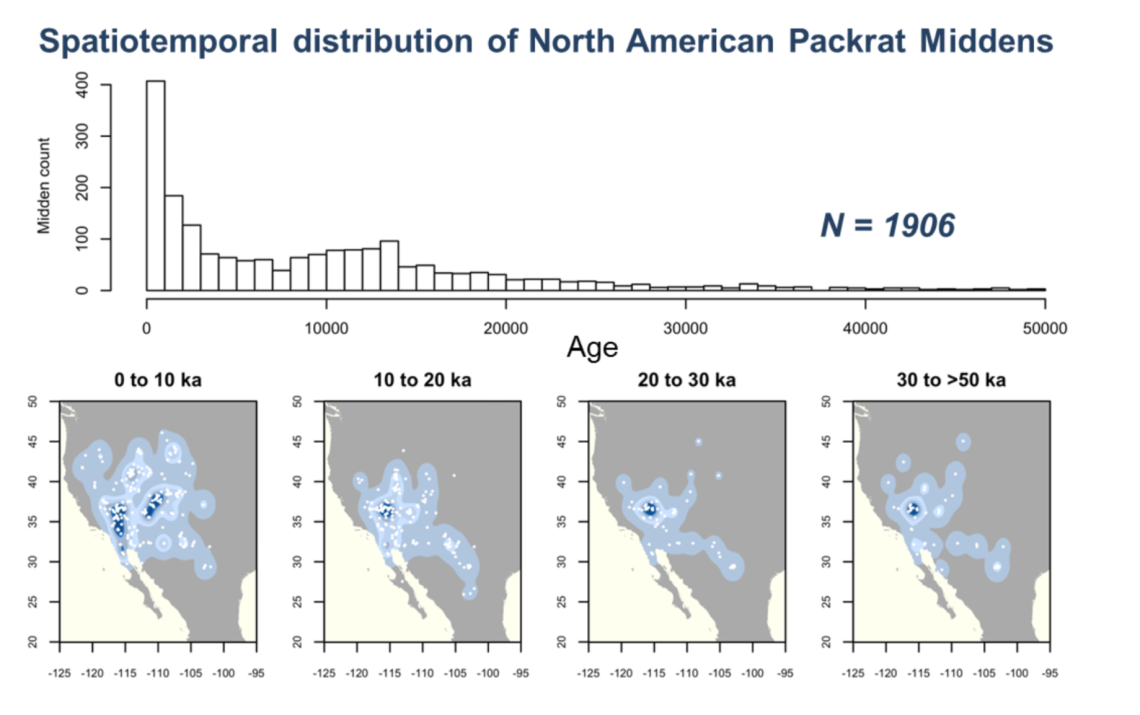.
Since 1960, more than 2,000 fossil packrat middens have been collected, dated, and analyzed from western North America, with nearly a third of these contained in the Desert Laboratory’s collection. These middens offer unrivaled taxonomic and spatial resolution, and hence unique perspectives, on the stability, disassembly, and assembly of local communities through major climatic events in the dynamic late Quaternary.
For nearly five decades, the University of Arizona has served as a hub for packrat midden research in North America (e.g., Betancourt et al. 1990, Packrat Middens: The Last 40,000 Years of Biotic Change. U of Arizona Press), providing training and support for many of its practitioners.
Midden data are archived at the USGS-NOAA North American Packrat midden Database (https://geochange.er.usgs.gov/midden/) and are also being incorporated into the Neotoma Paleoecology Database (https://www.neotomadb.org/).
Midden materials are among the richest and diverse sources of well- preserved plant and animal remains worldwide and have been used in clever and unique ways to investigate ecophysiological, phenotypic, genetic, distributional, and community response to climate variability and change. Despite important insights gained, the full range and abundance of information that can be extracted from middens remains to be explored, particularly in light of recent and impending advances in ancient DNA (aDNA), genomics, geochemistry, informatics, microscopy, and theoretical ecology.
The collection is open to researchers upon appointment. Please contact the Desert Laboratory (lynneschepartz@arizona.edu) for all inquiries.
Papers On Middens, Packrats, and Other Middens, by Region
Agenbroad, L.D., and Mead, J.I., 1994, Documented Quaternary climate change on the Colorado Plateau: 40,000 yr B.P.-present, in Waugh, W.J., ed., Proceedings of the Workshop, Climate Change in the Four Corners and Adjacent Regions: Implications for Environmental Restoration and Land-Use Planning, September 12-14, 1994, Mesa State College, Grand Junction, Colorado, p. 3-8.
Allen, C.D., Betancourt, J., and Swetnam, T.W., Landscape changes in the southwestern United States: Techniques, long-term data sets, and trends: United States Geological Survey, Retrieved April 22, 2007, from https://biology.usgs.gov/luhna/chap9.html.
Anderson, R.S., 1989, Development of the southwestern Ponderosa Pine forests: What do we really know?, in Multiresource Managment of Ponderosa Pine Forests: USDA Forest Service, Rocky Mountain Forest and Range Experiment Station General Technical Report, RM-185, Flagstaff, Arizona, p. 15-22.
Arundel, S.T., 2002, Modeling climate limits of plants found in Sonoran Desert packrat middens: Quaternary Research, v. 58, p. 112-121.
Ashworth, A.C., 1973, Fossil beetles from a fossil wood rat midden in western Texas: Coleopterists' Bulletin, v. 27, no. 3, p. 139-140.
Bailey, V., 1931, Mammals of New Mexico, in North American Fauna No. 53: Government Printing Office, Washington D.C., p. 170-192.
Baker, R.H., 1956, Mammals of Coahuila, Mexico: University of Kansas, Museum of Natural History Publications, v. 9, p. 127-335.
Beatley, J.C., 1976, Rainfall and fluctuating plant populations in relation to distributions and numbers of desert rodents in southern Nevada: Oecologia, v. 24, p. 21-42.
Bell, C.J., and Glennon, J., 2003, Arvicoline rodents from Screaming Neotoma Cave, southern Colorado Plateau, Apache County, Arizona, with comments on the Pleistocene biogeography of Lemmiscus curtatus, inB.W. Schubert, Mead, J.I., and Graham, R.W., eds., Ice Age Cave Faunas of North America: Indiana University Press, Indianapolis, p. 54-63.
Betancourt, J.L., Pierson, E.A., Rylander, K.A., Fairchild-Parker, J.A., and Dean, J.S., 1993, Influence of history and climate on New Mexico pinyon-juniper woodlands, in Aldon, E.F., and Shaw, D.W., eds., Managing Pinyon-Juniper Ecosystems for Sustainability and Social Needs; Proceedings of the Symposium at Santa Fe, New Mexico: USDA Forest Service, Rocky Mountain Forest & Range Experiment Station, Fort Collins, p. 42-62.
Betancourt, J.L., Van Devender, T.R., and Martin, P.S., 1990, Introduction, in Betancourt, J.L., Van Devender, T.R., and Martin, P.S., eds., Packrat Middens: The Last 40,000 Years of Biotic Change: University of Arizona Press, Tucson, p. 2-11.
Betancourt, J.L., Van Devender, T.R., and Martin, P.S., 1990, Synthesis and Prospectus, in Betancourt, J.L., Van Devender, T.R., and Martin, P.S., eds., Packrat Middens: The Last 40,000 Years of Biotic Change: University of Arizona Press, Tucson, p. 435-447.
Betancourt, J.L., Webb, R.S., Lixey, L.M., and Andrews, T.G., 2004, Paleo Slide Set: Packrat middens: Vegetation and climate variability in the southwestern United States, Retrieved April 23, 2007, from https://www.ncdc.noaa.gov/paleo/slides/slideset/index16.htm.
Birney, E.C., 1973, Systematics of three species of woodrats (genus Neotoma) in central North America: University of Kansas, Museum of Natural History, Miscellaneous Publication No. 58, Lawrence, 173 p.
Bleich, V.C., and Schwartz, O.A., 1975, Observations on the home range of the desert woodrat, Neotoma lepida intermedia: Journal of Mammology, v. 56, no. 2, p. 518-519.
Bonaccorso, F.J., and Brown, J.H., 1972, House construction of the desert wood rat, Neotoma lepida lepida: Journal of Mammalogy, v. 53, no. 2, p. 283-288.
Brakenridge, G.R., 1978, Evidence for a cold, dry full-glacial climate in the American Southwest: Quaternary Research, v. 9, p. 22-40.
Brown, J.H., 1968, Adaptation to environmental temperature in two species of woodrats, Neotoma cinerea and N. albigula: University of Michigan, Museum of Zoology, Miscellaneouos Publications, v. 135, p. 1-48.
Brown, J.H., and Lee, A.K., 1969, Bergmann's rule and climatic adaptation in woodrats (Neotoma): Evolution, v. 23, p. 329-338.
Brown, J.H., Lieberman, G.A., and Dengler, W.F., 1972, Woodrats and cholla: Dependence of a small mammal population on the density of cacti: Ecology, v. 53, p. 310-313.
Cameron, G.N., 1971, Niche overlap and competition in woodrats: Journal of Mammalogy, v. 52, no. 2, p. 288-296.
Cameron, G.N., and Rainey, D.G., 1972, Habitat utilization by Neotoma lepida in the Mohave Desert: Journal of Mammalogy, v. 53, no. 2, p. 251-266.
Charlet, D.A., 1995, Great Basin montane and subalpine conifer diversity: Dispersal or extinction pattern?: Ph. D. Dissertation, University of Neveda, Reno, 177 p.
Chess, T., and Chew, R.M., 1971, Weight maintenance of desert woodrat (Neotoma lepida) on some natural foods: Journal of Mammalogy, v. 52, no. 1, p. 193-195.
Cole, K.L., and Arundel, S.T., 2005, Carbon isotopes from fossil packrat pellets and elevational movements of Utah agave plants reveal the Younger Dryas cold period in Grand Canyon, Arizona: Geology v. 33 no. 9, p. 713-716.
Cole, K.L., and Mayer, L., 1982, Use of packrat middens to determine rates of cliff retreat in the eastern Grand Canyon, Arizona: Geology, v. 10, p. 597-599.
Cole, K.L., and Mayer, L., 1983, Comment and replies on use of packrat middens to determine rates of cliff retreat in the eastern Grand Canyon, Arizona: Geology, v. 11, no. 8, p. 494-495.
Connin, S.L., Betancourt, J.L., and Quade, J., 1998, Late Pleistocene C4 plant dominance and summer rainfall in the southwestern United States from isotopic study of herbivore teeth: Quaternary Research, v. 50, p. 179-193.
Dalquest, W.W., and Strangl, F.B., Jr., 1984, Late Pleistocene and early recent mammals from Fowlkes Cave, southern Culberson County, Texas, in Genoways, H.H., and Dawson, M.R., eds., Contributions in Quaternary Vertebrate Paleontology: A Volume in Memorial to John E. Guilday: Special Publications of the Carnegie Museum of Natural History, No.8, Pittsburgh, p. 432-455.
Davis, O.K., 2001, Pollen analysis of 26WP12, Lower Pictograph Cave, Great Basin National Park, White Pine Co., Nevada: Report Submitted to Western Archaeological and Conservation Center, Tucson, Arizona, 1-17 p.
Davis, O.K., Agenbroad, L.D., Martin, P.S., and Mead, J.I., 1984, The Pleistocene dung blanket of Bechan Cave, Utah, in Genoways, H.H., and Dawson, M.R., eds., Contributions in Quaternary Vertebrate Paleontology: A Volume in Memorial to John E. Guilday: Special Publications of the Carnegie Museum of Natural History, No. 8, Pittsburgh, p. 267-282.
Davis, O.K., and Sellers, W.D., 1987, Contrasting climatic histories for western North America during the early Holocene: Current Research in the Pleistocene, v. 4, p. 87-89.
Dial, K.P., and Czaplewski, N.J., 1990, Do woodrat middens accurately represent the animal's environment and diets? The Woodhouse Mesa study, in Betancourt, J.L., Van Devender, T.R., and Martin, P.S., eds., Packrat Middens: The Last 40,000 Years of Biotic Change: University of Arizona Press, Tucson, p. 43-58.
Dixon, J., 1919, Notes on the natural history of the bushy-tailed wood rats of California, in Kofoid, C.A., and Grinnell, J., eds., University of California Publications in Zoology: University of California Press, Berkeley, p. 49-74.
Douglas, D. 2007, Analysis of future climate for WCS, Andrews County, Texas low-level radioactive disposal site: URS Corporation, San Diego.
Eaton, J., 2003, Potent packrat leavings tempted starving 49ers: Berkeley Daily Planet, Retrieved April 18, 2005, from http://www.berkeleydailyplanet.com/article.cfm?archiveDate=12-12-03&storyID=17931.
Elias, S.A., 1990, Observations on the taphonomy of late Quaternary insect fossil remains in packrat middens of the Chihuahuan Desert: Palaios, v. 5, no. 4, p. 356-363.
Elliot-Fisk, D.L., Adkins, B.S., and Spaulding, J.L., 1983, A re-evaluation of the postglacial vegetation of the Laramie Basin, Wyoming-Colorado: The Great Basin Naturalist, v. 43, no. 3, p. 377-384.
English, P.F., 1923, The dusky-footed woodrat (Neotoma fuscipes): Journal of Mammalogy, v. 4, no. 1, p. 1-8.
Finley, R.B., Jr., 1990, Woodrat ecology and behavior and the interpretation of paleomiddens, in Betancourt, J.L., Van Devender, T.R., and Martin, P.S., eds., Packrat Middens: The Last 40,000 Years of Biotic Change: University of Arizona Press, Tucson, p. 28-42.
Finley, R.B., Jr., 1992, Formation and occurrence of calcium oxalate deposits on rocks at wood rat (Neotoma) dens, Annual Meeting of the American Society of Mammologists, June, 1992: Salt Lake City, Utah, p. 1-17.
Finley, R. B., Jr. 2004, Biology of wood rats as cave dwellers and collectors, in Barnosky, A.D., ed., Biodiversity Response to Climate Change in the middle Pleistocene - The Porcupine Cave Fauna From Colorado: University of California Press, Berkeley, p. 74-81.
Force, C.P., 1992, Late Quaternary Neotoma biogeography of the western Grand Canyon: M.S. Thesis, Northern Arizona University, Tucson, 112 p.
Gibson, J.D., 1993, Natural responses to Quaternary climatic change in the greater Nevada Test Site region, U.S.A.: Quaternary International, v. 20, p. 131-142.
Gillespie, W.B. 1985, Holocene climate and environment in Chaco Canyon, New Mexico, in Mathien, F.J., ed., Environment and subsistence of Chaco Canyon, New Mexico: National Park Service, Albuquerque, p. 13-45.
Golenberg, E.M., 1999, Isolation, identification and authentication of DNA sequences derived from fossil material, in Jones, T.P., and Rowe, N.P., eds., Fossil Plants and Spores: modern techniques: Geologic Society, London, p. 156-160.
Grayson, D.K., 1993a, Chapter 6: The late Pleistocene vegetation of the Great Basin, in The Desert's Past: A Natural Prehistory of the Great Basin: P. S. P. E. Associates, Smithsonian Institution Press, Washington and London.
Grayson, D.K., 1993b, Chapter 7: The late Pleistocene vertebrates of the Great Basin, in The Desert's Past: A Natural Prehistory of the Great Basin: P. S. P. E. Associates, Smithsonian Institution Press, Washington and London.
Grayson, D.K., 1993c, Chapter 8: The Great Basin during the Holocene, in The Desert's Past: A Natural Prehistory of the Great Basin: P. S. P. E. Associates, Smithsonian Institution Press, Washington and London.
Grayson, D.K., and Livingston, S.D., 1989, High-elevation records for Neotoma cinerea in the White Mountains, California: Great Basin Naturalist, v. 49, no. 3, p. 392-395.
Grayson, D.K., Livingston, S.D., Rickart, E., and Shaver, M.W.I., 1996, Biogeographic significance of low-elevation records for Neotoma cinerea from the northern Bonneville Basin, Utah: The Great Basin Naturalist, v. 56, no. 3, p. 191-196.
Hallett, J.C., and Wigand, P.E., 2001, The role of dietary fiber in the dung size of bushy-tailed woodrats, Neotoma cinerea: Its potential application to paleoclimatic interpretation: Western North American Naturalist, v. 61, no. 1, p. 57-63.
Hall, W.E., T.R. Van Devender and C.A. Olson. 1988. Late Quaternary Arthropod Remains from Sonoran Desert Packrat Middens, Southwestern Arizona and Northwestern Sonora. Quaternary Research. 29: 277-293.
Hall, W.E., C.A. Olson and T.R. Van Devender. 1989. Late Quaternary and Modern Arthropods from the Ajo Mountains of Southwestern Arizona. Pan-Pacific Entomologist. 65(3): 322-347.
Hall, W.E., T.R. Van Devender and C.A. Olson. 1990. Arthropod history of the Puerto Blanco Mountains, Organ Pipe Cactus National Monument, Southwestern Arizona. In "Fossil Packrat Middens: The last 40,000 years of Biotic Change in the Arid West" (P.S. Martin, T.R. Van Devender, J.L. Betancourt, Eds.). Univ. of Arizona Press, Tucson.
Hansen, R.M., 1978, Shasta ground sloth food habits, Rampart Cave, Arizona: Paleobiology, v. 4, no. 3, p. 302-319.
Harris, A.H., 1984, Neotoma in the late Pleistocene of New Mexico and Chihuahua, in Genoways, H.H., and Dawson, M.R., eds., Contributions in Quaternary Vertebrate Paleontology: A Volume in Memorial to John E. Guilday: Special Publications of the Carnegie Museum of Natural History, No. 8, p. 164-178.
Harris, A.H. 1985, Late Pleistocene Vertebrate Paleoecology of the West: University of Texas Press, Austin.
Horton, J.S., and Wright, J.T., 1944, The wood rat as an ecological factor in southern California watersheds: Ecology, v. 25, no. 3, p. 341-351.
Ingles, L.G., 1965, Wood rats (Neotoma), in Ingles, L.G., ed., Mammals of the Pacific States, California, Oregon and Washington: Stanford University Press, Stanford, p. 266-273.
Ireland, P.H., and Hays, H.A., 1969, A new method for determining the home range of woodrats: Journal of Mammalogy, v. 50, no. 2, p. 378-379.
Jackson, G.F., 1965, Defense Cave - Its geology, paleontology, and biology: National Speleological Society News, v. 23, no. 6, p. 88-90.
Jahren, A.H., Amundson, R., Kendall, C., and Wigand, P.E., 2001, Paleoclimatic reconstruction using the correlation in delta 18O of hackberry carbonate and environmental water, North America: Quaternary Research, v. 56, p. 252-263.
Jennings, J.D., 1980, Cowboy Cave: Anthropological Papers University of Utah, Salt Lake City, 224 p.
Lewin, R., 1985, Plant communities resist climatic change: Science, v. 228, p. 165-166.
Lindsdale, J.M., and Tevis, L.P., Jr., 1951, Population, in Lindsdale, J.M., and Tevis, L.P., Jr., eds., The Dusky-Footed Wood Rat: University of California Press, Berkeley, p. 595-599.
Livo, L.J., 1992, The pinon and the pack rat: Colorado Outdoors, p. 20-23.
Lomolino, M.V., Brown, J.H., and Davis, R., 1989, Island biogeography of montane forest mammals in the American southwest: Ecology, v. 70, no. 1, p. 180-194.
Mallouf, R.J., 1981, Observations concerning environmental and cultural interactions during the terminal Pleistocene and early Holocene in the Big Bend of Texas and adjoining regions: Bulletin of the Texas Archeological Society, v. 52, p. 121-146.
Markgraf, V., 1985, Plant inertia reassessed: The American Naturalist, v. 127, no. 5, p. 725-726.
Martin, P.S., 1969, Pollen analysis and the scanning electron microscope: Proceedings of the Second Annual SEM Symposium, IIT Research Institute, Chicago, p. 89-102.
McCarten, N.F., 1981, Fossil cacti and other succulents from the late Pleistocene: Cactus and Succulent Journal, v. 53, p. 122-123.
McClure, P.A., and Randolph, J.C., 1980, Relative allocation of energy to growth and development of homeothermy in the eastern wood rat (Neotoma floridana) and hispid cotton rat (Sigmodon hispidus): Ecological Monographs, v. 50, no. 2, p. 199-219.
McGinley, M.A., 1984, Central place foraging for nonfood items: Determination of the stick-size value relationship of house building materials collected by eastern woodrats: American Naturalist, v. 123, no. 6, p. 841-853.
Mclane, A.R., ˜1971, Amberat: With Special Reference To Nevada, 1-17 p.
Mclane, A.R., 1973, Caves of the Mt. Moriah planning unit, Ely Ranger District, White Pines County, Nevada: A Summary Report: Humbolt National Forest, 1-28 p.
Mclane, A.R., 1968, Queen City and Snowslide Caves, Central Nevada, National Speleological Society Report: Reno, Nevada, no. 4292, p. 1-11.
Mclane, A.R., 1974, Eastern Nevada Cave Hunt, August 1974: Cave Lights, v. 18, p. 7-11.
Mead, J.I., 1980, In search of ancient pack rats: Natural History, p. 40-45.
Medville, D., 1998, Haystack Cave: A cave of volcanic origin in Colorado: Rocky Mountain Caving, v. 15, no. 1, p. 19-21.
Mehringer, P.J., 1977, Great Basin environments and chronology, in Fowler, D.D., ed., Models and Great Basin Prehistory: A Symposium: Desert Research Institute Publications in the Social Sciences, v. 12, p. 113-167.
Mehringer, P.J., 1985, Late-Quaternary pollen records from the interior Pacific Northwest and northern Great Basin of the United States, in Bryant, V.M., Jr., and Holloway, R.G., eds., Pollen Records of Late Quaternary North American Sediments: American Association of Stratigraphic Palynologists (AASP) Foundation, Dallas, p. 167-189.
Mensing, S.A., Elston, R.G., Raines, G.L., Tausch, R.J., and Nowak, C.L., 2000, A GIS model to predict the location of fossil packrat (Neotoma) middens in central Nevada: Western North American Naturalist, v. 60, no. 2, p. 111-120.
Miller, J., Germanoski, D., Waltman, K., Tausch, R., and Chambers, J., 2001, Influence of late Holocene hillslope processes and landforms on modern channel dynamics in upland watersheds of central Nevada: Geomorphology, v. 38, p. 373-391.
Miller, R.F., and Wigand, P.E., 1994, Holocene changes in semiarid pinyon-juniper woodlands: BioScience, v. 44, no. 7, p. 465-474.
Morgan, A.V., Morgan, A., Ashworth, A.C., and Matthews, J.V., Jr., 1983, Late Wisconsin fossil beetles in North America, in Porter, S.C., ed., Late-Quaternary Environments of the United States: The Late Pleistocene: University of Minnesota Press, Minneapolis, p. 354-363.
Nowak, R.S., Nowak, C.L., and Tausch, R.J., 2000, Probability that a fossil absent from a sample is also absent from the paleolandscape: Quaternary Research, v. 54, p. 144-154.
O'Rourke, M.K., 1991, Pollen in packrat middens: The contribution of filtration: Grana, v. 30, p. 337-341.
Orr, P.C., 1957, Observations on the occurrence and nature of "amberat": Western Speleological Institute, Inc. No. 2, 3 p.
Phillips, A.M., III., and VanDevender, T.R., 1974, Pleistocene packrat middens from the lower Grand Canyon of Arizona: Journal of the Arizona Academy of Science, v. 9, no. 3, p. 117-119.
Plummer, M.A., Phillips, F.M., Fabryka-Martin, J., Turin, H.J., Wigand, P.E., and Sharma, P., 1997, Chlorine-36 in fossil rat urine: An archive of cosmogenic nuclide deposition during the past 40,000 years: Science, v. 277, p. 538-541.
Quade, J., 2001, Desert pavements and associated rock varnish in the Mojave Desert: How old can they be?: Geology, v. 29, no. 9, p. 855-858.
Repenning, C.A., 2004, Fossil wood rats of Porcupine Cave, tectonic of climatic controls, in Barnosky, A.D., ed., Biodiversity response to climate change in the middle Pleistocene - the Porcupine Cave fauna from Colorado: Univeristy of California Press, Berkeley, p. 193-206.
Rogers, K., 1997, Dung happens: Las Vegas Review-Journal, Retrieved 1/25/2005, from http://www.reviewjournal.com/lvrj_home/1997/Jul-02-Wed-1997/news/5620319.html.
Rogers, S.O., and Bendich, A.J., 1985, Extraction of DNA from milligram amounts of fresh herbarium and mummified plant tissues: Plant Molecular Biology, v. 5, p. 69-76.
Rogers, T.S., 1964, Biological observations with emphasis on the vegetation of the Black Gap Wildlife Management Area, Brewster County, Texas: M.A. Thesis, Sul Ross State College, Alpine, Texas, 128 p.
Rose, M.R., and Wigand, P.E., 1999, Southern California climate change: The past 2,000 years, in Rose, M.R., and Wigand, P.E., eds., Southern California Climate Symposium, October 25, 1991: Natural History Museum of Los Angeles County, v. 11, p. 1-5.
Santucci, V.L., Kenworthy, J., and Kerbo, R., 2001, An inventory of paleontological resources associated with National Park Service caves: Geologic Resources Division Technical Report, National Park Service, Lakewood, CO, p. 50.
Schnabel, A., Hamrick, J.L., and Wells, P.V., 1993, Influence of Quaternary history on the population genetic structure of douglas-fir (Pseudotsuga menziesii) in the Great Basin: Canadian Journal of Forestry Research, v. 23, p. 1900-1906.
Schramm, D., 1984, Pack-rat middens hold key to past: Park Science: A Resource Management Bulletin, v. 4, no. 2, p. 19.
Sears, P.B., and Roosma, A., 1961, A climatic sequence from two Nevada caves: American Journal of Science, v. 259, p. 669-678.
Smith, F.A., Betancourt, J.L., and Brown, J.H., 1995, Evolution of body size in the woodrat over the past 25,000 years of climate change: Science, v. 270, p. 2012-2014.
Spaulding, W.G., 1990, Comparison of pollen and macrofossil based reconstructions of late Quaternary vegetation in western North America: Review of Palaeobotany and Palynology, v. 64, p. 359-366.
Spaulding, W.G., 1991, Pluvial climatic episodes in North America and North Africa: Types and correlation with global climate: Palaeogeography, Palaeoclimatology, Palaeoecology, v. 84, p. 217-227.
Spaulding, W.G., Betancourt, J.L., Croft, L.K., and Cole, K.L., 1990, Packrat middens: Their composition and methods of analysis, in Betancourt, J.L., Van Devender, T.R., and Martin, P.S., eds., Packrat Middens: The Last 40,000 Years of Biotic Change: University of Arizona Press, Tucson, p. 59-84.
Stones, R.C., and Hayward, C.L., 1968, Natural history of the desert woodrat, Neotoma lepida: American Midland Naturalist, v. 80, no. 2, p. 458-476.
Tausch, R.J. and Nowak, C.L., 2000, Influences of Holocene climate and vegetation changes on present and future community dynamics: Journal of Arid Land Studies v. 10S, p. 5-8.
Tausch, R.J., Nowak, C.L., and Mensing, S.A., 2004, Climate change and associated vegetation dynamics during the Holocene: the paleoecological record, in Chambers, J.C., and Miller, J.R., eds., Great Basin Riparian Areas, Ecology, Managment, and Restoration: Island Press, Washington, p. 24-48.
Tausch, R.J., Wigand, P.E., and Burkhardt, J.W., 1993, Viewpoint: Plant community thresholds, multiple steady states, and multiple successional pathways: Legacy of the Quaternary: Journal of Range Management, v. 46, no. 5, p. 439-447.
Thompson, R.S., 1988, Western North America: Vegetation dynamics in the western United States: Modes of response to climatic fluctuations, in Huntley, B., and Webb, T., III, eds., Vegetation History: Kluwer Academic, Dordrecht, The Netherlands, p. 415-458.
Thompson, R.S., Anderson, K.H., and Bartlein, P.J., 1999, Quantitative paleoclimatc reconstuctions from late Pleistocene plant macrofossils of the Yucca Mountain Region: U.S. Geological Survey, Open File Report 99-338, 38 p.
Thompson, R.S., and Anderson, K.H., Past climate and vegetation change in the southwestern United States: USGS, Retrieved 4/30/07, from https://geochange.er.usgs.gov/sw/impacts/biology/pastclim/.
Thompson, R.S., and Kautz, R.R., 1983, Paleobotany of Gatecliff Shelter: Pollen analysis of Gatecliff Shelter, in Thomas, D.H., ed., The Archaeology of Monitor Valley. 2. Gatecliff Shelter: American Museum of Natural History Anthropological Papers.
Thompson, R.S., and Schaefer, J., 1986, Environment, in Pendleton, L., ed., The Archaeology of Picacho Basin, Southwest California: Wirth Environmental Services, Division of Dames and Moore, San Diego, p. 8-11.
Thorne, R.F., 1986, A historical sketch of the vegetation of the Mojave and Colorado Deserts of the American Southwest: Annals of the Missouri Botanical Garden, v. 73, no. 3, p. 642-651.
Van de Water, P.K., Leavitt, S.W., and Betancourt, J.L., 1994, Trends in stomatal density and 13C/12C ratios of Pinus flexilis needles during Last Glacial-Interglacial cycle: Science, v. 264, p. 239-243.
Van Devender, T., 1983, Our first curators: Sonorensis, v. 5, no. 3, p. 4-10.
Van Devender, T.R., 1986, Climatic cadences and the composition of Chihuahuan Desert communities: The late Pleistocene packrat midden record, in Diamond, J., and Case, T.J., eds., Community Ecology: Harper & Row, New York, p. 285-299.
Van Devender, T.R., 1988, Pollen in packrat (Neotoma) middens: Pollen transport and the relationship of pollen to vegetation: Palynology, v. 12, p. 221-229.
Van Devender, T.R., A.M. Rea and W. E. Hall. 1991. Faunal Analysis of Late Quaternary Vertebrates from Organ Pipe Cactus National Monument, Southwestern Arizona. Southwestern Naturalist. 36(1): 94-106.
Van Devender, T.R. and W.E. Hall. 1993. Fossil Arthropods from the Sierra Bacha, Sonora, Mexico. Ecologica. 3(1): 1-12.
Van Devender, T.R. and W.E. Hall. 1994. Holocene Arthropods from the Sierra Bacha, Mexico, with Emphasis on Beetles (Coleoptera). Coleopterists Bulletin, 48(1): 30-50.
Vaughan, T.A., 1990, Ecology of living packrats, in Betancourt, J.L., Van Devender, T.R., and Martin, P.S., eds., Packrat Middens: The Last 40,000 Years of Biotic Change: University of Arizona Press, Tucson, p. 14-27.
Vestal, E.H., 1938, Biotic relations of the wood rat (Neotoma fuscipes) in the Berkeley hills: Journal of Mammalogy, v. 19, no. 1, p. 1-36.
Waugh, W.J., and Petersen, K.L., 1994, Paleoclimatic data application: Long-term performance of uranium mill tailings repositories, in Waugh, W.J., ed., Climate Change in the Four Corners and Adjacent Regions: Implications for Environmental Restoration and Land-Use Planning, September 12-14, 1994, Mesa State College, Grand Junction, Colorado, p. 163-185.
Webb, R.H., 1986, Spatial and temporal distribution of radiocarbon ages on rodent middens from the southwestern United States: Radiocarbon, v. 28, no. 1, p. 1-8.
Webb, R.H., and Betancourt, J.L., 1990, The spatial and temporal distribution of radiocarbon ages from packrat middens, in Betancourt, J.L., Van Devender, T.R., and Martin, P.S., eds., Packrat Middens: The Last 40,000 Years of Biotic Change: University of Arizona Press, Tucson, p. 240-258.
Wells, P.V., 1977, Reply to Comments by Van Devender: Quaternary Research, v. 8, p. 238-239.
Wells, P.V., 1979, An equable glaciopluvial in the west — Periglacial evidence of increased precipitation on a gradient from the Great Basin to the Sonoran and Chihuahuan deserts: Quaternary Research, v. 12, no. 3, p. 311-325.
Wharton, R.A., Wigand, P.E., Rose, M.R., Reinhardt, R.L., Mouat, D.A., Kleiforth, H.E., Ingraham, N.L., Davis, J.O., Fox, C.A., and Ball, J.T., 1990, The North American Great Basin: A sensitive indicator of climatic change, in Osmond, C.B., Pitelka, L.F., and Hidy, G.M., eds., Plant Biology of the Basin and Range: Springer-Verlag, New York, p. 323-359.
Whitlock, C., 1990, Paleoecological troves: Science, v. 250, p. 1021-1022.
Wigand, P.E., 1994, Stable isotopic analyses in paleoclimatic reconstruction, in Waugh, W.J., ed., Proceedings of the Workshop, Climate Change in the Four Coners and Adjacent Regions: Implications for Envionmental Restoration and Land-Use Planning, September 12-14, 1994, Mesa State College, Grand Junction, Colorado, p. 27-38.
Wigand, P.E., 1999, Stable isotopes in biotic materials and regional climatic reconstruction, in Rose, M.R., and Wigand, P.E., eds., Proceedings of the Southern California Climate Symposium, Trends and Extremes of the Past 2000 Years, October 25, 1991: Natural History Museum of Los Angeles County, v. 11, p. 119-138.
Wigand, P.E., Hemphill, M.L., and Patra, S.M., 1994, Late Holocene climate derived from vegetation history and plant cellulose stable isotope records from the Great Basin of western North America, in Proceedings of the Fifth Annual International High Level Radioactive Waste Management Conference and Exposition, May 22-26, 1994, Las Vegas, Nevada, p. 2574-2583.
Wigand, P.E., and Mehringer, P.J., 1985, Pollen and seed analysis, in Thomas, D.H., ed., The Archaeology of Hidden Cave, Nevada: Anthropological Papers of The American Museum of Natural History, New York, v. 61, p. 108-124.
Withers, K., 1989, Late Quaternary vegetation and climate of Forty-Mile Canyon and Willow Gulch, in the central Colorado Plateau: M.S. Thesis, Northern Arizona University, Tucson, 71 p.
Withers, K., and Mead, J.I., 1993, Late Quaternary vegetation and climate in the Escalante River Basin on the Central Colorado Plateau: Great Basin Naturalist, v. 53, no. 2, p. 145-161.
Woolfenden, W.B., 1996, Quaternary vegetation history, Sierra Nevada Ecosytem Project, Final Report to Congress, vol 2, Assessments and scientific basis for managment options: Centers for Water and Wildland Management, University of California, Davis, p. 47-70.
Wright, K., 1993, Revelations of rat scat: Discover, p. 64-71.
Yarrow, H.C., 1875, Collections of batrachians and reptiles, in Wheeler, G.M., ed., Exploration and Surveys, Zoology: U.S. Army Department of Engineering, Washington, D.C, v. 5, p. 559-562.
Berry, S.L., 1991, The potential of fossil mammal middens as indicators of vegetation hsitory in central Australia: Australian Journal of Botany, v. 39, p. 305-313.
Betancourt, J.L., Rylander, K.A., Latorre, C., and Maldonado, A., 2001, Late Quaternary vegetation history of Quebrada de Chaco (25°30' S, 2650-3450 m) in the hyperarid transitional zone between summer and winter rainfall regimes, Atacama Desert, Chile, Proceedings from the Central Andean Paleoclimate Workshop, January 11-16th: Tucson, Arizona.
Fall, P.L., 1990, Deforestation in southern Jordan: Evidence from fossil Hyrax middens, in Bottema, S., Entjes-Nieborg, G., and Van Zeist, W., eds., Man's Role in the Shaping of the Eastern Mediterranean Landscape: Balkema, Rotterdam, p. 271-281.
Fall, P.L., Lindquist, C.A., and Falconer, S.E., 1990, Fossil Hyrax middens from the Middle East: A record of paleovegetation and human disturbance, in Betancourt, J.L., Van Devender, T.R., and Martin, P.S., eds., Packrat Middens the Last 40,000 Years of Biotic Change: Unversity of Arizona Press, Tucson, p. 408-427.
Green, N., Caldwell, J., Hope, J., and Luly, J., 1983, Pollen from an 1800 year old stick-nest rat (Leporillus sp.) midden from Gnalta, western New South Wales: Quaternary Australasia, v. 1, no. 1-2, p. 31-41.
Holmgren, C.A., 2000, A Holocene history of the northern Atacama Desert (16 degrees S) from fossil rodent middens: M.S. Thesis, The University of Arizona, Tucson, 36 p.
Holmgren, C.A., Betancourt, J.L., Rylander, K.A., Roque, J., Tovar, O., Zeballos, H., and Linares, E., 2001, Holocene vegetation history from fossil rodent middens near Arequipa, Peru: Quaternary Research, v. 56, p. 242-251.
Latorre, C., Betancourt, J.L., and Arroyo, M.T.K., 2004, Evidence from rodent middens from summer rainfall variability over the last 22,000 years from northern Chile's Rio Salado (22° S), poster presented at AGU Annual Meeting.
Markgraf, V., Betancourt, J.L., and Rylander, K.A., 1997, Late-Holocene rodent middens from Rio Limay, Neuquen Province, Argentina: The Holocene, v. 7, no. 3, p. 325-329.
McCarthy, L., Head, L., and Quade, J., 1996, Holocene palaeoecology of the nothern Flinders Ranges, South Australia, based on stick-nest rat (Leporillus spp.) middens: A preliminary overview: Palaeogeography, Palaeoclimatology, Palaeoecology, v. 123, p. 205-218.
Nelson, D.J., Webb, R.H., and Long, A., 1990, Analysis of stick-nest rat (Leporillus: Muridae) middens from central Australia, in Betancourt, J.L., Van Devender, T.R., and Martin, P.S., eds., Packrat Middens the Last 40,000 Years of Biotic Change: Unversity of Arizona Press, Tucson, p. 428-434.
Pearson, O.P., and Christie, M.I., 1993, Rodent guano (amberat) from caves in Argentina: Studies on Neotropical Fauna and Environment, v. 28, no. 2, p. 105-111.
Pearson, S., and Betancourt, J.L., 2002, Understanding arid environments using fossil rodent middens: Journal of Arid Environments, v. 50, p. 499-511.
Pearson, S., and Dodson, J.R., 1993, Stick-nest rat middens as sources of paleoecological data in Australian deserts: Quaternary Research, v. 39, p. 347-354.
Pearson, S., Lawson, E., Head, L., McCarthy, L., and Dodson, J.R., 1999, The spatial and temporal patterns of stick rat middens in Australia: Radiocarbon, v. 41, no. 3, p. 295-308.
Quade, J., Bird, M.I., and Chivas, A.R., Late Pleistocene and early Holocene stick-nest rat middens from the Gammon Ranges, South Australia, p. 31.
Scott, L., 1990, Hyrax (Procaviidae) and Dassie Rat (Petromuridae) middens in paleoenvironmental studies in Africa, in Betancourt, J.L., Van Devender, T.R., and Martin, P.S., eds., Packrat Middens the Last 40,000 Years of Biotic Change: Unversity of Arizona Press, Tucson, p. 398-407.
Scott, L., and Vogel, J.C., 1992, Short-term changes of climate and vegetation revealed by pollen analysis of hyrax dung in South Africa: Review of Palaeobotany and Palynology, v. 74, p. 283-291.
Scott, L., and Vogel, J.C., 2000, Evidence for environmental conditions during the last 20,000 years in southern Africa from 13C in fossil hyrax dung: Global and Planetary Change, v. 26, p. 207-215.


